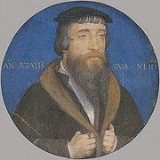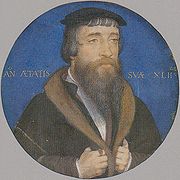
William Roper
Encyclopedia

Margaret Roper
Margaret Roper was an English writer and translator. She was the daughter of Thomas More and wife of William Roper. During More's imprisonment in the Tower of London, she was a frequent visitor to his cell, along with her husband.Roper married William Roper in 1521 in Eltham, Kent...
, daughter of Sir Thomas More
Thomas More
Sir Thomas More , also known by Catholics as Saint Thomas More, was an English lawyer, social philosopher, author, statesman and noted Renaissance humanist. He was an important councillor to Henry VIII of England and, for three years toward the end of his life, Lord Chancellor...
. He wrote a highly regarded biography of his father-in-law.
Life
William Roper was the eldest son of John Roper (d. 1524), Attorney-General to Henry VIIIHenry VIII of England
Henry VIII was King of England from 21 April 1509 until his death. He was Lord, and later King, of Ireland, as well as continuing the nominal claim by the English monarchs to the Kingdom of France...
, and his wife Jane (died c.1544), daughter and coheir of Sir John Fyneux, Chief Justice of King's Bench. The Ropers were an ancient Kent
Kent
Kent is a county in southeast England, and is one of the home counties. It borders East Sussex, Surrey and Greater London and has a defined boundary with Essex in the middle of the Thames Estuary. The ceremonial county boundaries of Kent include the shire county of Kent and the unitary borough of...
ish family, owners of the manor of St Dunstan outside the West Gate of Canterbury
Canterbury
Canterbury is a historic English cathedral city, which lies at the heart of the City of Canterbury, a district of Kent in South East England. It lies on the River Stour....
, since known as the Roper Gate. He was educated at one of the English
England
England is a country that is part of the United Kingdom. It shares land borders with Scotland to the north and Wales to the west; the Irish Sea is to the north west, the Celtic Sea to the south west, with the North Sea to the east and the English Channel to the south separating it from continental...
universities, and was appointed Clerk of the Pleas in the Court of King's Bench, a post previously held by his father, holding the post until shortly before his death. Aged about twenty-three it is thought he joined the household of Sir Thomas More, marrying Margaret, More's eldest daughter, in 1521.
Erasmus
Desiderius Erasmus
Desiderius Erasmus Roterodamus , known as Erasmus of Rotterdam, was a Dutch Renaissance humanist, Catholic priest, and a theologian....
, who knew More and his family well, described Roper as a young man "who is wealthy, of excellent and modest character and not unacquainted with literature". Roper became a convert to the Lutheran
Lutheranism
Lutheranism is a major branch of Western Christianity that identifies with the theology of Martin Luther, a German reformer. Luther's efforts to reform the theology and practice of the church launched the Protestant Reformation...
doctrine of Justification by Faith
Justification (theology)
Rising out of the Protestant Reformation, Justification is the chief article of faith describing God's act of declaring or making a sinner righteous through Christ's atoning sacrifice....
and spoke so freely of his belief that he was summoned to appear before Cardinal Wolsey on an accusation of heresy
Heresy
Heresy is a controversial or novel change to a system of beliefs, especially a religion, that conflicts with established dogma. It is distinct from apostasy, which is the formal denunciation of one's religion, principles or cause, and blasphemy, which is irreverence toward religion...
. More often disputed with Roper over his belief. He said to his daughter, To these prayers by More, Roper attributed his return to Catholicism
Roman Catholic Church
The Catholic Church, also known as the Roman Catholic Church, is the world's largest Christian church, with over a billion members. Led by the Pope, it defines its mission as spreading the gospel of Jesus Christ, administering the sacraments and exercising charity...
.
He was a member of various Parliaments between 1529 and 1558. Although he remained a Roman Catholic, he was permitted to retain his office of prothonotary
Prothonotary
The word prothonotary is recorded in English since 1447, as "principal clerk of a court," from L.L. prothonotarius , from Greek protonotarios "first scribe," originally the chief of the college of recorders of the court of the Byzantine Empire, from Greek protos "first" + Latin notarius ; the -h-...
of the Court of King's Bench after the accession of Elizabeth I
Elizabeth I of England
Elizabeth I was queen regnant of England and Ireland from 17 November 1558 until her death. Sometimes called The Virgin Queen, Gloriana, or Good Queen Bess, Elizabeth was the fifth and last monarch of the Tudor dynasty...
. However, his diatribe against Elizabeth's late mother, Anne Boleyn
Anne Boleyn
Anne Boleyn ;c.1501/1507 – 19 May 1536) was Queen of England from 1533 to 1536 as the second wife of Henry VIII of England and Marquess of Pembroke in her own right. Henry's marriage to Anne, and her subsequent execution, made her a key figure in the political and religious upheaval that was the...
, in his biography of More earned him the enmity of many Elizabethan loyalists and Protestants.
His biography
Biography
A biography is a detailed description or account of someone's life. More than a list of basic facts , biography also portrays the subject's experience of those events...
of Sir Thomas More was written during the reign of Queen Mary
Mary I of England
Mary I was queen regnant of England and Ireland from July 1553 until her death.She was the only surviving child born of the ill-fated marriage of Henry VIII and his first wife Catherine of Aragon. Her younger half-brother, Edward VI, succeeded Henry in 1547...
nearly twenty years after More's death, but was not printed until 1626, when it became a primary source for More's earliest biographers because of Roper's intimate knowledge of his father-in-law.
In popular culture
Roper was a character in Robert BoltRobert Bolt
Robert Oxton Bolt, CBE was an English playwright and a two-time Oscar winning screenwriter.-Career:He was born in Sale, Cheshire. At Manchester Grammar School his affinity for Sir Thomas More first developed. He attended the University of Manchester, and, after war service, the University of...
's famous play A Man for All Seasons
A Man for All Seasons
A Man for All Seasons is a play by Robert Bolt. An early form of the play had been written for BBC Radio in 1954, and a one-hour live television version starring Bernard Hepton was produced in 1957 by the BBC, but after Bolt's success with The Flowering Cherry, he reworked it for the stage.It was...
, being portrayed (however accurately) as a contrarian, somewhat thick-headed man who would always oppose whatever doctrine was the established one. In the 1966 film
A Man for All Seasons (1966 film)
A Man for All Seasons is a 1966 film based on Robert Bolt's play A Man for All Seasons about Sir Thomas More. It was released on December 12, 1966. Paul Scofield, who had played More in the West End stage premiere, also took the role in the film. It was directed by Fred Zinnemann, who had...
of the play, he was portrayed by Corin Redgrave
Corin Redgrave
Corin William Redgrave was an English actor and political activist.-Early life:Redgrave was born in Marylebone, London, the only son and middle child of actors Michael Redgrave and Rachel Kempson...
.

